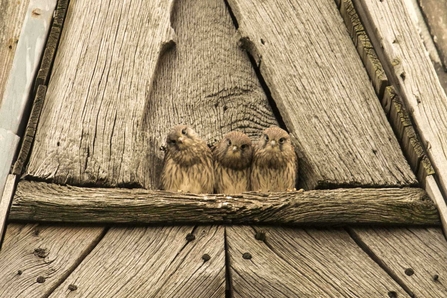
Hovering kestrel credit Steve Waterhouse
Be a Kestrel Counter
Kestrels live across London - but where, and how many do we have?
Nationally, kestrels have undergone an overall decline over the long term. However, their population has fluctuated over this period, showing an increase in numbers some years - so is this happening in London?
We need Londoners to get kestrel counting and tell us where you've seen these magnificent birds of prey in order to help establish the numbers and whereabouts of city's current population.
Add your sightings to our Kestrel Count form here
As a result of changes in the countryside surrounding London, the city has become much more important for wildlife.
London Wildlife Trust launched its first Kestrel Count in 1988 during which, kestrels were seen at some iconic tall buildings including the Tower of London, Palace of Westminster, St Giles Church in Covent Garden and at the Barbican.
They were spotted in every borough, with an estimated total of 400 pairs nesting in London.
Our latest survey will allow us to build up a picture of any changes in kestrel numbers over the last 25 years. We know that their population in London declined during the 1990s, but the picture over the last decade has been unclear.
We hope that Kestrel Count will provide us with some useful data. Sightings of birds - or even knowledge of where they are not known to be present - are important to help us shape how we act to conserve and protect them.

Credit Bob Coyle
How to be an urban Kestrel Counter and identify a kestrel
What shape are its wings? In flight a kestrels' pointed wings look longer than their bodies; they are thinner than a pigeon's.
What shape is its tail? In flight a kestrel's tail looks longer than its body, but it fans out when hovering.
An adult kestrel's orangey-brown plumage is speckled and spotted with darker markings, and paler underneath (males have a paler grey head and are more rusty coloured above).
Closer views show a darker 'tear-stained' line running vertically down from the large dark eye.

Kestrel chicks credit Philip Braude
Kestrel facts and figures
-
Kestrels are medium-sized falcons that are often associated with rough grassland and roadside verges;
-
They are found in a wide variety of habitats, and have even adapted to inner cities - kestrels have been recorded across London, they are the most widespread bird of prey in the capital;
-
They have extremely keen eyesight, and famously often 'hover' in their search for food;
-
Their favoured food is small rodents (often voles and mice), but they also eat, worms, beetles, small birds and insects;
-
Urban kestrels are more likely to hunt small birds because of the lack of availability of small mammals;
-
Kestrels nest in cavities, old nests or on ledges, and will use nest-boxes where necessary;
-
A clutch usually contains four or five eggs, which take about a month to hatch - After another month or so, the chicks leave the nest, and (unusually for birds of prey) will often stay together after fledging;
-
Kestrels are 'amber-listed' (of moderate conservation concern) because of recent declines in the UK and Europe;
-
Kestrels are fully protected by law and it is illegal to harm or unnecessarily disturb them.
What's in a name?
Kestrel - from old French 'crecle' - to rattle, probably imitative of "kee-kee-kee" call.
Windhover/Hoverhawk/Windsucker/Windcuffer - from habit of hovering.
Stannel Hawk - from Old English 'stangale' or 'stone-yeller'. This name comes mainly from areas where kestrels perch on stones and boulders and lay their eggs on rocky ledges.
Moosie Hawk/Mouse Falcon - from the mice which are the main part of the kestrel's diet in rural areas.
